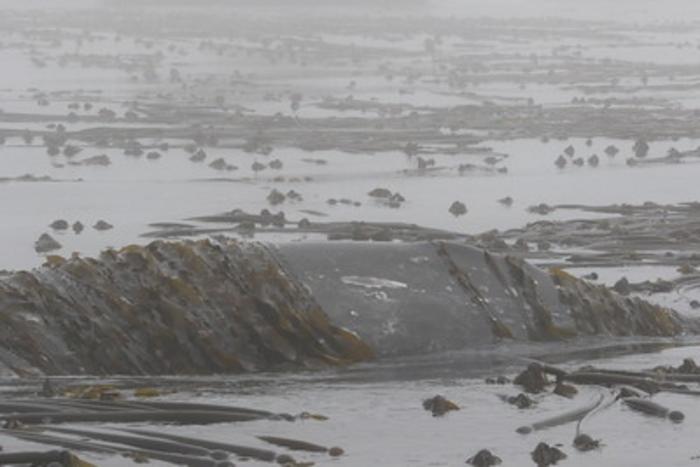NEWPORT, Ore. – A recent boom in the purple sea urchin population off the southern Oregon Coast appears to have had an indirect and negative impact on the gray whales that usually forage in the region, a new study shows.

Credit: GEMM Lab, Marine Mammal Institute, Oregon State University.
NEWPORT, Ore. – A recent boom in the purple sea urchin population off the southern Oregon Coast appears to have had an indirect and negative impact on the gray whales that usually forage in the region, a new study shows.
When urchin numbers rise, the spiky marine invertebrates can devour kelp forests that are a critical habitat for zooplankton, the tiny aquatic organisms that are the primary prey of many marine animals. Damaged kelp forests lead to reductions in zooplankton, and with fewer zooplankton to feed on, gray whales spend less time foraging there, researchers with Oregon State University’s Marine Mammal Institute found.
“This study shows the cascading impacts of a change in the coastal ocean ecosystem in a way that has not been documented before,” said the study’s lead author, Lisa Hildebrand, a doctoral candidate in the Marine Mammal Institute’s Geospatial Ecology of Marine Megafauna Laboratory. “These impacts extend indirectly to a top predator, the gray whale, and it affects them in a negative way.”
The study was recently published in Nature Scientific Reports. Co-authors are Associate Professor Leigh Torres, who leads the GEMM Lab at Hatfield Marine Science Center in Newport, and researchers Solène Derville and Ines Hildebrand of Torres’ lab.
Sea urchin populations began to explode off the coast of Oregon following the Sea Star Wasting Syndrome pandemic that began in 2013. The pandemic led to an estimated 90% decline in sunflower sea stars, which are now listed as critically endangered.
Historically off the coast of Oregon, sunflower sea stars have been one of two natural predators of sea urchin. The other is the sea otter, which was wiped out of Oregon waters by fur trappers more than 100 years ago.
“In ecology, we think about the important role of redundancy in an ecosystem,” Torres said. “This is a good example of an ecosystem that lacks redundancy due to the loss of sea otters. The system could not sustain itself without both the otters and the sea stars.”
Sea urchins are naturally occurring in kelp forests, but the decline in sunflower sea stars meant there was no predator to keep the population in check. The researchers began to see the effects of that change in the ecosystem during their annual gray whale monitoring research in Port Orford.
Torres and her team have been monitoring gray whales and their environment in that region since 2015 as part of a 10-year study of the foraging ecology of gray whales in the Pacific Coast Feeding Group. This small subset of whales frequents near-shore waters along the Oregon and Pacific Northwest coast rather than traveling to the Arctic to forage each summer.
The research team, which includes local high school students and college undergraduates, spends six weeks each summer at OSU’s Port Orford Field Station. The location is ideal because there’s a large, protected cove that allows researchers to monitor whales easily from shore and also gives them access to the water, where they can collect zooplankton samples by kayak and use GoPro cameras to monitor underwater conditions.
“The overall goal of the research is to better understand what gray whales are feeding on near shore,” Lisa Hildebrand said. “We first started to see these dramatic images of sea urchins feeding on the kelp in 2018 and even more in 2019.”
The sea urchin-kelp dynamic has been well-studied, but this is the first study that looks beyond that relationship to the impacts on zooplankton that inhabit the kelp forest and their predators – the gray whales.
The researchers found that as the kelp was damaged or destroyed, fewer zooplankton, and in particular the tiny mysid shrimp that make up a big portion of the gray whale’s diet, remained in the near-shore waters. With fewer zooplankton in the area, the gray whales spent less time foraging there.
“In 2020 and 2021, we saw fewer whales and the whales we saw spent less time in that area,” Torres noted. “We also noted declines in gray whales’ body condition during these years while conducting other field studies off the coast of Newport.”
The researchers can’t say how exactly the decline in kelp leads to a decline in zooplankton, but they suspect the zooplankton may be using the kelp as a type of shelter, and it may be that zooplankton are retained within kelp beds because tides and currents are weaker inside these areas than outside, Hildebrand said.
The study highlights the ripple effects of ocean warming due to climate change, the researchers noted.
“Marine heatwaves and warmer ocean waters likely worsened the Sea Star Wasting Syndrome pandemic and young kelp tends to grow better in colder water. As a result, there was less drift kelp available for urchins to feed on in the nearshore system,” Lisa Hildebrand said.
In 2023, the researchers noted that the region showed signs of recovery, with fewer urchins and more kelp, zooplankton and whales. These recent observations may be signs of the ecosystem returning to conditions favorable for kelp growth.
“We think and we hope this system is recovering and we’ll continue to monitor it through our research,” Torres said. “Oregonians love having gray whales feeding along our coast and they need a healthy habitat to ensure that continues.”
The Marine Mammal Institute is part of Oregon State’s College of Agricultural Sciences and is based at Hatfield Marine Science Center. The study was funded in part by Oregon Sea Grant.
Journal
Scientific Reports
Method of Research
Observational study
Subject of Research
Animals
Article Title
Exploring indirect effects of a classic trophic cascade between urchins and kelp on zooplankton and whales
Article Publication Date
29-Apr-2024



